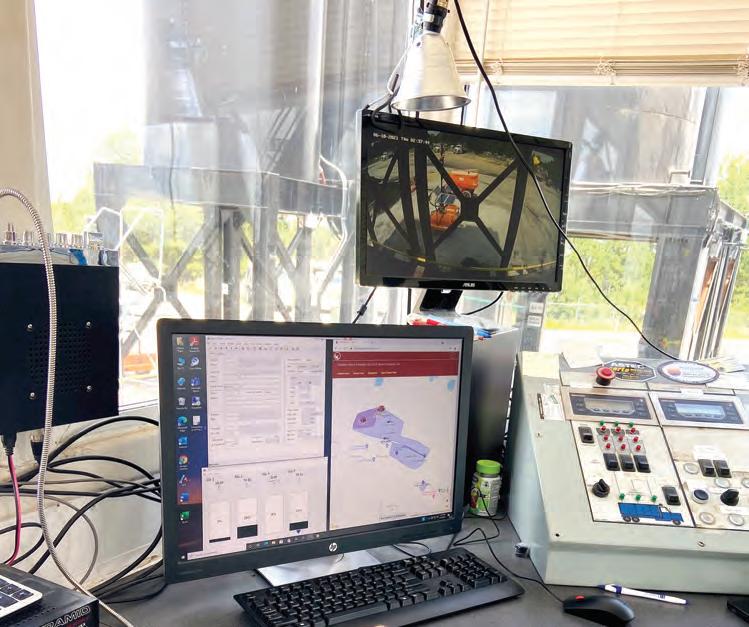
15 minute read
VOLVO CONSTRUCTION EQUIPMENT INCREASES SALES, PROFITABILITY








iD g
oM re. UB LDI R ORM E. OD OM .ER













CEPEX OREFROTM CREXUOMY .RTO TAVCA
yna eslee rehw eras rotavacx eOCLEBOK, erot mego e tdam cae enod h uoyn ahty ad reve
KOBELCO-USA.COM




















21-KO OBELCO-0642 _ NewDealer _ 21-KOBELCO-0642_NewDealer_Ad d2 _ RUN.indd 1 _Ad2_RUN.indd 1
Scott Equipment 14635 Valley Blvd. Fontana, CA 92335 909-822-2200 • 800-316-0327 www.scottequip.com Orion Equipment 18060 Des Moines Memorial Drive Seattle, WA 98148 800-280-8124 www.orion-equip.com
TRUCKING from page 1
The Safe Driver Apprenticeship Pilot Program will train drivers so they can cross state lines in their rigs, according to ATA. Chris Spear, CEO, said last fall that this program was needed and would help alleviate some of the driver shortage.
Until now, federal regulations allow only those at least 21 years of age to drive semis across state lines. The new regulation will allow anyone at least 18 years of age with a state-issued CDL and a clean record to drive interstate trucks under the direct supervision of an experienced driver.
The pilot program is part of the Infrastructure Investment and Jobs Act, signed into law this past November. Here’s how it will work: • An exemption to the normal age restrictions will be issued to each driver admitted to the program, and trucks used will be required to have certain safety technologies. • Those technologies include automatic emergency braking, forward-facing video cameras and a top speed limited to 65 miles per hour. • Apprentice drivers will not be allowed to drive trucks with more than one trailer or trucks carrying hazardous materials. • The experienced driver must be at least 26 years old and have at least five years of experience driving semis. • The supervising driver also is required to have had two years of incident-free driving before training the new driver.
Last year, the ATA cheered the Federal Motor Carrier Safety Administration for the pilot program’s development.
The pilot program, he said, will “set out a path for these drivers to fully participate in our industry by allowing them to drive interstate.”
Spear called the move “a common-sense step” that has support from a broad coalition.
Trucking safety advocates are concerned about the potential dangers of putting inexperienced drivers behind the wheel of a big rig. Many also are concerned about the burden of increased insurance coverage required for younger drivers.
“We don’t see any benefits to a categorical lowering of the age to 18 across the board for long-haul trucking,” said Norita Taylor, OOIDA director of public relations.
“We would like to see training standards improved and the elimination of the exemption for truck drivers in the Federal Labor Standards Act,” she said.
Trucking for Veterans
In December, The Biden-Harris Trucking Action Plan was announced. It was developed to expand recruiting efforts and elevate the appeal of careers in trucking.
The plan emphasizes apprenticeship programs like the Safe Driver pilot program, but also beefs up efforts to recruit former members of the military for trucking careers.
Bill Sullivan, ATA vice president of advocacy, said the association is encouraged that the Biden administration recognized the need for more drivers and created a “robust training opportunity for future commercial truck drivers.”
Sullivan said apprenticeships will help jobseekers pursue a career in trucking for good wages and benefits in a safe manner without significant debt many can incur.
The plan targets military veterans, encouraging them to consider trucking as a civilian career.
Annually, approximately 200,000 service members transition to civilian life. Over the past five years, some 70,000 veterans left the service with military trucking experience, according to the Biden administration.
“It’s an incredible opportunity to do right by our veterans and strengthen the trucking workforce at the same time to ensure there are seamless paths to these opportunities for our veterans,” said an administration official.
But like construction contractors, independent truckers say the need to recruit is nothing new. Retention is more critical, they believe. The program may draw more young people into trucking, but what’s being done to keep them in the industry?
The Owner-Operator Independent Drivers Association believes the driver shortage claim is a myth.
The association believes the issues affecting the supply chain today are not due to a lack of drivers, but because of excessive detention time and other inefficiencies.
Trucking is plagued by retention issues and, at times, an unattractive working environment due to long hours and inadequate compensation, according to the group.
Addressing compensation, working conditions and the parking shortage would go a long way in improving retention OOIDA’s members, most of whom are small businesses, maintain.
Going Further
The Trucking Action Plan includes initiatives to support drivers and improve retention while expanding access to quality driving jobs. The White House gave a status report on its initiatives in January.
The White House reports more than 100 employers and industry partners have stepped forward to work to expand apprenticeships over a 30-day period.
The Departments of Labor and Transportation launched the 90-Day Trucking Apprenticeship Challenge as a strategy for helping employers and organized labor partners develop and retain a skilled workforce, according to the White House.
Beside the 100 employers expanding drive apprenticeships, more than 20 employers are already close to launching brand new apprenticeships.
This will put thousands of new skilled and safe drivers on the road in good trucking jobs trained using the “earn while you learn” registered apprenticeship model, according to the White House.
Labor, transportation and industry partners continue to meet with employers, industry groups and labor organizations to support the development of apprenticeships across the industry.
The Women of Trucking Advisory Board, mandated in the Bipartisan Infrastructure Law, was created to increase the number of women in trucking.
The board will review and report on challenges facing woman drivers and those interested in joining the profession, including barriers to entry, on-the-job safety risks, mentorship, quality training and opportunities for advancement.
The White House also convened a virtual roundtable to gather input on how to build a more inclusive and equitable workplace for women in the trucking industry.
Also created was a mandated task force to investigate predatory truck leasing arrangements with DOL and the Consumer Financial Protection Bureau.
The FMCSA, Labor and the CFPB formed a truck leasing task force to identify actions that could make leases more equitable and transparent. The task force will be focused on inequitable terms and transparency in common truck leasing arrangements.
It will review truck leasing arrangements for ports that involve a requirement for trucks to convert to zero emissions, as well as loans and other arrangements between incoming driver trainees and training schools or trucking companies to understand instances of outsized and unanticipated debt for incoming drivers.
The group also will look into predatory truck leasing arrangements with DOL and in coordination with the CFPB.
Two studies to explore issues of driver pay and unpaid detention time were launched. FMCSA released a scope of work for a study on driver detention time and its impact on safety and compensation.
This study will use a cross section of electronic logging device data to provide a detailed understanding of wait times for drivers across jurisdictions and industry sectors.
Data used will be aggregated and anonymized to ensure driver privacy. The study also will review how detention time influences the likelihood of a crash or an hours-of-service violation.
The Safe Driver Apprenticeship Pilot also was launched during the 30 days. And, more than $32 million in funding to improve the CDL licensing process was earmarked for states.
FMCSA and the Transportation Research Board will study the impacts of methods of driver compensation on safety and driver retention. The study will review the safety effect of payments made per load or per mile versus payments per hour.
The study also will review the amount of time a truck driver spends away from home, driving and detained to determine true working hours, and then determine true hourly wages.
“In some parts of the trucking industry, 90 percent of drivers turn over each year,” said Transportation Secretary Pete Buttigieg.
Trucks & Trailers SECTION


To view our current comparison trailer specification charts visit www.constructionequipmentguide.com
Pages 39-42
Telematics Tackles Details to Enhance Efficiency for Firm
They say that the devil is in the details. For a company that has been around since 1923 and employs more than 700 employees, E.R. Snell Contractor Inc. has a lot of details to deal with every day.
The family-operated company based in Atlanta, Ga., performs a variety of transportation construction jobs from Augusta to Macon and northern Georgia including roadway work, structural bridge work and asphalt paving and sales. On any given summer day, E.R. Snell is dispatching 150 to 200 asphalt trucks, a vast majority of which are third party truckers.
In handling their daily trucking, Executive Vice President Jared Snell knew there had to be a better way to manage the mountain of details that impact his company’s operations. Thankfully, he was right, and in an innova-
tive telematics platform, they found a way to handle the details and exorcise their demons.
Accountability Helps Efficiency

FleetWatcher’s mobile app continuously relays information from GPS-enabled transponders in trucks to computer screens in offices and mobile phones or tablets out in the field.
For Snell, this information created accountability with drivers.
“It’s the accountability of the trucks now that we have…That was what we purchased [FleetWatcher] for, to verify what we were spending was right,” said Snell.
With new insight into its trucking operations through FleetWatcher’s Material Management Solution (MMS), E.R. Snell reduced unauthorized driver stops and quickly identify other problems that weren’t even on its radar. After watching its trucking costs rise year after year Snell was relieved to see them drop and eventually stabilize after implementing FleetWatcher.
A large reason for the decline in costs came from how E.R. Snell pays its thirdparty truckers. Before having a handle on its trucking, the company was paying trucks by the ton to encourage efficiency. Unfortunately, E.R. Snell didn’t have an efficient way to track and identify why some trucks got five loads a night while others got two. To make matters worse, all the trucks ended up getting paid the same and high demand drove up costs across the board.
Armed with FleetWatcher, Snell and his team were able to ensure when they came back to I-285 that trucks were paid for their exact tonnage and not a pound more.
When onboarding its third-party drivers Snell was pleasantly surprised by the response to FleetWatcher. The drivers embraced the new technology not as a bigbrother tool looming over their shoulder but as a tool to help them logistically and save money in the trucking process. Plus, a streamlined implementation process didn’t scare anyone away in the process.


Fact-Based Decisions Replace Intuition
The E.R. Snell team is very familiar with I-285. Whether it’s northbound or southbound, the team has resurfaced stretches of the interstate from the South Carolina border through Atlanta. The asphalt team was working on one particular 3 mi., four to six lane wide, stretch of I-285 at Atlanta’s Hartsfield International Airport when their telematics system helped them make sense out of the onslaught of information involved in the 100,000 ton, four-month project.
An immediate way Snell and his managers cut through the noise was to eliminate overtrucking in real-time. In previous highway projects the team deferred to superintendents and foremen for their opinions on the trucking needs for a particular job. In hindsight, both parties tended to overestimate the amount of trucks needed.
Due to its FleetWatcher telematics system, E.R. Snell was able to see where trucks were at all times, eliminate the grouping and generally keep a steady stream from the asphalt plant to the paver. Distinguishing between fact and opinion allowed it to eliminate several trucks a day to get the right number of trucks on the job.
“This past year, what we found by using FleetWatcher is that we were able to quickly identify shortfalls… Our managers were able to understand if they’ve got delays or if they’ve got problems, where trucks are and what they’re doing,” said Snell of the new insight into their asphalt operations.
Another such shortfall was E.R. Snell’s ability to not only know the right number of trucks for a job, but that its trucks were where they were supposed to be.
Before telematics, trucks would take millings, valued between $60 to $100 for use in future mixes and make unauthorized stops to sell them. Now armed with more information, the E.R. Snell team had a direct line of sight into where all of their trucks were in the field in real-time.


Unintended Outcomes Sweeten The Pot
More efficient trucking was an intended outcome of E.R. Snell’s investment in MMS. Company wide visibility into trucking performance metrics, was not. The information is displayed on large screens with intuitive graphics at the asphalt plants, and on smaller screens like tablets and smartphones through the app.
“I’d say the value add that we got that I didn’t see coming was the managers’ use of the app. They have found it from the foreman, up through the project manager, and even through the executive level. The use of the app has been invaluable for logistics and just, overall, a dashboard view of what’s going on during the day,” said Snell.
For more information, visit www.EarthwaveTech.com.





